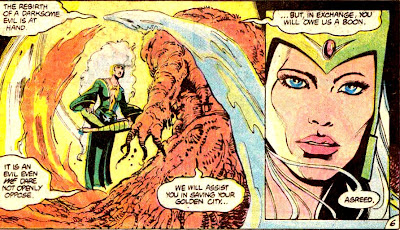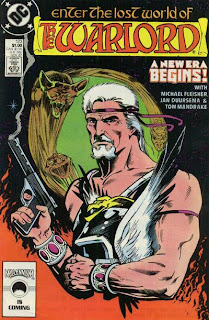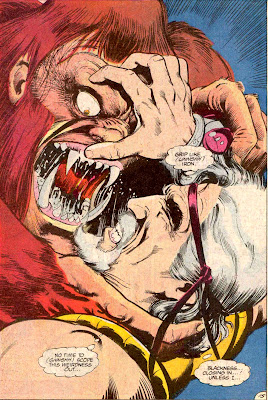Warlord #124 (December 1987)
Written by Michael Fleisher; Pencils by Jan Duursema, Inks by Tom Mandrake
Synopsis: Morgan goes running across the devastated and burning city of Shamballah to the palace and his mate, Tara. He finds her in the ruins, trying to rescue a girl stuck under a timber. Together Morgan and Tara free her but then find themselves surrounded by flames. Kara aka Power Girl swoops in to rescue them.
Meanwhile, Jennifer thinks something more than a natural disaster is going on. In her sanctum, she summons “benevolent elementals” to query them:
While our heroes fight the fires and advancing lava in Shamballah, the three inhuman sorcerers swarm around a golden, skull-adorned casket—the thing that was inside the crystal egg. Their Mistress has survived the crossing. “Let evil rejoice.”
To revitalize herself, she sucks up the energy of one of her lackeys. Then she tells them to go out and find more fools to serve her.
After hours of dealing with the disaster, Morgan and Tara return to their bed chamber. They’re still filled with a sense of foreboding—and they should be, because at that moment, two-bit Aquaman foe, the Scavenger is shooting his way past their guards and into the palace. He uses his scorpion ship to bust into the palace vault.
Morgan’s awakened from sleep. His keen plot senses detect that something’s afoot. He and Tara surprise the Scavenger mid-theft. Scavenger knocks out Tara and grazes Morgan’s shoulder with a shot. He thinks he’s free and clear to escape in his craft. He’s mistaken:
The ship crashes. Morgan beats the hell out of the Scavenger and would kill him, but Tara intervenes. Scavenger may have lost the battle, but he’s just the kind of scum the sorcereress Khnathaiti needs. She transports him to her lair and offers him a job.
The Scavenger isn’t impressed by her magic tricks or her offer. He’s a bit more impressed when she syphons the energy from another of her servants, and transforms herself from an old crone to a beautiful younger woman. Has she moves closer to him, the Scavenger asks if she’s going to “waste him.” The sorcereress replies: “No part of you is going to be wasted, Scavenger. It shall all be…used.”
While the sorceress does her evil work, Jennifer and Kara are making their good-byes. The elementals told Jennifer that Kara was needed back on earth. Reluctantly, Kara leaves to return to the DCU proper.
Meanwhile, Khnathaiti’s work is done:
- Morgan thinks (for some reason) that Skartaris doesn't need superheroes.
- Khnathaiti is even worse on henchmen than the usual evil mastermind.
Where It Comes From:
The Scavenger (Peter Mortimer) first appeared in Aquaman #37 (February 1968). He was always looking for an ancient alien device called the "Time Deccelerator." Apparently, he eventually found it and that's what ultimately landed him in Skartaris, where he shows up in issue #118. He went from a couple of other changes and retcons beyond the one here before getting killed in Hawkman #15 (1994).
Kara does indeed return to Earth, and next appears a few months later in Infinity, Inc. #50.
The Scavenger (Peter Mortimer) first appeared in Aquaman #37 (February 1968). He was always looking for an ancient alien device called the "Time Deccelerator." Apparently, he eventually found it and that's what ultimately landed him in Skartaris, where he shows up in issue #118. He went from a couple of other changes and retcons beyond the one here before getting killed in Hawkman #15 (1994).
Kara does indeed return to Earth, and next appears a few months later in Infinity, Inc. #50.

























